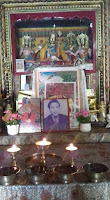BB
Gurung: “The guilt of having participated in the process of the merger has left
a very deep and painful scar in my heart”
Ten years after his controversial move to
declare ‘Prince’ Wangchuk the 13th Chogyal of Sikkim, Bhim Bahadur Gurung
admitted that he had always felt uncomfortable and somewhat guilty at having
been a party to the ‘selling of Sikkim’. Gurung saw the Chogyal’s death and his
funeral on February 19, 1982, as a god-sent opportunity to expiate himself of
the sins he had committed, and made attempts to ventilate his true feelings. In
1975, Gurung moved a resolution in the Assembly, abolishing “the institution of
the Chogyal” and declaring Sikkim to be a “constituent unit of India”, thereby
paving way for Sikkim to become the 22nd State of the Indian Union.
 |
| BB Gurung |
“The guilt of having participated in the
process of the merger has left a very deep and painful scar in my heart”,
Gurung confided to me at his residence in Gangtok one afternoon in mid-1992.
“By publicly acknowledging Prince Wangchuk to be the 13th Chogyal of Sikkim, I
wanted to exonerate myself and get rid of this guilt,” Gurung explained. He
revealed that he, then legislative leader of the Opposition, and his MLAs had
made a controversial move in openly accepting Wangchuk as the 13th Chogyal of
Sikkim on February 19, 1982, and thereby acknowledging the traditional process
by which the Chogyals succeeded to the throne. If in 1975, Gurung was a party
to the abolition of the Chogyal’s institution, in 1982, he more than made up
for his past misdeeds by publicly acclaiming Wangchuk to be the 13th consecrated
Chogyal of Sikkim and acknowledging the continuance of the Chogyals’ hereditary
succession.
Wangchuk’s response to his ‘crowning’ more
than satisfied Gurung, who was ready to pay any price for his action, which was
of great historical significance. In an interview in India Today after he was proclaimed the 13th Chogyal of Sikkim,
Wangchuk stated: “It is not for me to proclaim myself the new Chogyal. It is
for the people to accept and acknowledge me as the new Chogyal and you can see
for yourself the support I have been shown by the people…We do have the custom
of automatic succession that on the death of the Chogyal, the heir apparent
becomes the new Chogyal.”
 |
| Chogyal Palden Thondup Namgyal |
“I was all prepared to face any consequence
and was even ready to get arrested and face jail sentence,” Gurung pointed out
to me, and added, “Even my family members were conscious of what I was doing
and were prepared to face any eventuality.” Referring to the Chogyal’s
“enthronement”, Gurung said the people expected Bhandari, who was then the
Chief Minister, to back him. “But his handling of the situation showed that
Bhandari’s patriotism was superficial,” Gurung explained.
Gurung boasts that unlike some MLAs, he
stuck to his stand and refused to compromise and withdraw his signature from
the historic document submitted to Wangchuk on February 19. Sunanda K.
Datta-Ray in his book – Smash and Grab:
Annexation of Sikkim, describes Gurung as a “leading architect” and
“prominent” among those who bartered away the Kingdom’s independence. Referring
to Gurung’s opportunistic tendencies, the book adds: “In the distant past,
Gurung had enthusiastically defended his King’s demand for independence; but he
had recanted his loyalty to become one of New Delhi’s most loyal adherents in
Sikkimese politics.”
Gurung’s nationalistic feelings surfaced
when he was one of the three Executive Councillors of the Chogyal’s Sikkim
Council way back in 1967, when the demand for revision of the Indo-Sikkim
Treaty of 1950 by the Sikkimese, was worrying New Delhi. A joint statement on
the Treaty revision issued by the three Executive Councillors – Netuk Tsering
(Sikkim National Party), Nahakul Pradhan (Sikkim State Council), and B.B.
Gurung (Sikkim National Congress) – on June 15, 1967, stated: “Since Sikkim
signed the treaty with India, surely it is within her sovereign rights to
demand a revision of the treaty as one of the signatories. In fact Sikkim
gained her Sovereign Status on the 15th August, 1947, when India achieved her
independence from the British rule. Every country has its inherent right to
exist and maintain its separate identity and, therefore, to review and revise
its treaty obligations in the wake of changing circumstances.”
 |
| Chogyal Wangchuk Namgyal |
Though
Gurung’s political actions in the past may have been motivated by occasional
nationalistic feelings, his confession about his attempt to atone himself of
the political sins he had committed during the merger era, reflected the
painful experience and the burden of guilt that all merger veterans have had to
live with.
(Ref: Inside
Sikkim: Against The Tide, Jigme N. Kazi, 1993)



















